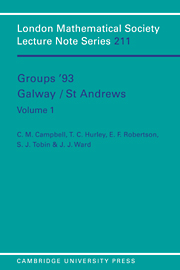Book contents
- Frontmatter
- Contents
- Preface
- Introduction
- Geometry, Steinberg representations and complexity
- The structure of metabelian finite groups
- Table algebras of extended Gagola-type and applications to finite group theory
- On the saturation of formations of finite groups
- Locally constructed formations of finite groups
- Reflections on virtually one-relator groups
- Rickard equivalences and block theory
- Computing the conjugacy classes of elements of a finite group
- Quotient categories of modules over group algebras
- Weak chain conditions for non-almost normal subgroups
- Computation of the character table of affine groups using Fischer matrices
- The lattice of compact representations of an infinite group
- Automorphisms of nilpotent and related groups
- Generation of orthogonal groups over finite fields
- The structure of certain Coxeter groups
- n-free groups and questions about universally free groups
- Classification of all generating pairs of two generator Fuchsian groups
- Parametric words and models of the elementary theory of non-abelian free groups
- The groups G(n, l) as fundamental groups of Seifert fibered homology spheres
- Lifting automorphisms: a survey
- (MI)-groups acting uniserially on a normal subgroup
- Revisiting a theorem of Higman
- Cohomological finiteness conditions
Classification of all generating pairs of two generator Fuchsian groups
Published online by Cambridge University Press: 02 March 2010
- Frontmatter
- Contents
- Preface
- Introduction
- Geometry, Steinberg representations and complexity
- The structure of metabelian finite groups
- Table algebras of extended Gagola-type and applications to finite group theory
- On the saturation of formations of finite groups
- Locally constructed formations of finite groups
- Reflections on virtually one-relator groups
- Rickard equivalences and block theory
- Computing the conjugacy classes of elements of a finite group
- Quotient categories of modules over group algebras
- Weak chain conditions for non-almost normal subgroups
- Computation of the character table of affine groups using Fischer matrices
- The lattice of compact representations of an infinite group
- Automorphisms of nilpotent and related groups
- Generation of orthogonal groups over finite fields
- The structure of certain Coxeter groups
- n-free groups and questions about universally free groups
- Classification of all generating pairs of two generator Fuchsian groups
- Parametric words and models of the elementary theory of non-abelian free groups
- The groups G(n, l) as fundamental groups of Seifert fibered homology spheres
- Lifting automorphisms: a survey
- (MI)-groups acting uniserially on a normal subgroup
- Revisiting a theorem of Higman
- Cohomological finiteness conditions
Summary
Introduction
A Fuchsian group is a discrete subgroup F of PSL2(ℝ) or a conjugate of such a group in PSL2(ℂ). A discrete subgroup G of PSL2(ℂ) is elementary if any two elements of infinite order (regarded as linear fractional transformations) have at least one common fixed point. This is equivalent to the fact that the commutator of any two elements of infinite order has trace 2. The structure of elementary subgroups of PSL2(ℝ) is well-known {see [6]} so for this paper we concentrate on non-elementary groups and use the term Fuchsian group to refer to a non-elementary discrete subgroup F of PSL2(ℝ) or a conjugate of such a group in PSL2(ℂ).
The purpose of this note is to present a complete classification, in one location, of the possibilities for generating pairs for two-generator Fuchsian groups. Specifically we prove the four main theorems listed below. These results have appeared in many different locations {see [26] for a discussion} but it would be convenient and important to have the proofs in just one place. The techniques we employ are straightforward and depend only on the properties of linear fractional transformations and their traces. Before stating the theorems we need some basic ideas from both Fuchsian group theory and abstract combinatorial group theory.
- Type
- Chapter
- Information
- Groups '93 Galway/St Andrews , pp. 205 - 232Publisher: Cambridge University PressPrint publication year: 1995
- 7
- Cited by



